Why I Wait to Feed These 5 Foods
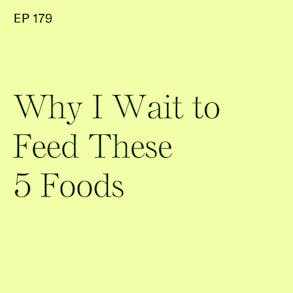
LISTEN TO THIS EPISODE
Episode Description
Babies can eat MOST foods if they’re prepared safely...but there are a few baby-led weaning foods I prefer to wait to feed. Inside of this episode I’m breaking down 5 foods that I wait on when teaching babies how to eat...and why!
Links from this Episode
- Baby-Led Weaning with Katie Ferraro program with the 100 First Foods™ Daily Meal Plan, join here: https://babyledweaning.co/program
- Baby-Led Weaning for Beginners free online workshop with 100 First Foods™ list to all attendees, register here: https://babyledweaning.co/baby-led-weaning-for-beginners
Other Episodes Related to this Topic
- Episode 75 - Canned Foods that CAN Work for Baby-Led Weaning
- Episode 4 - Gagging vs. Choking: What is the Difference?
- Episode 19 - Meat: How to Prepare Meat Safely for Baby-Led Weaning
- Episode 24 - Water: When to Offer Your Baby Water and How Much
- Episode 101 - Straw Cup vs. Open Cups: Which Comes First? with Dawn Winkelmann, MS, CCC-SLP

Latest Episodes
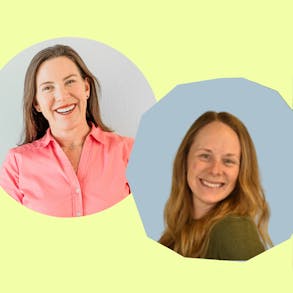
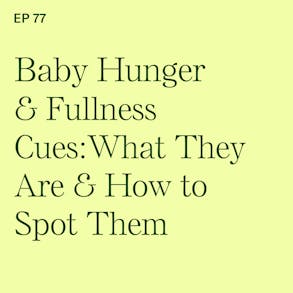
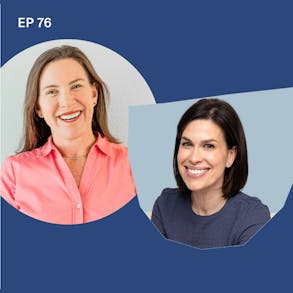
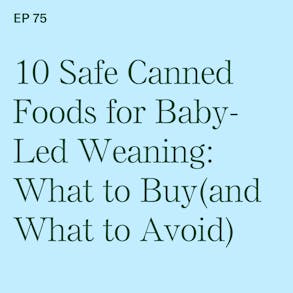
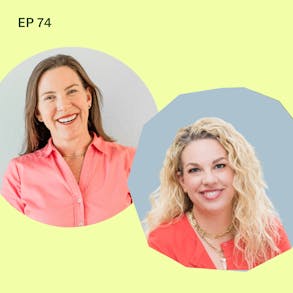
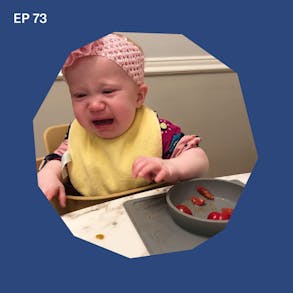
Katie Ferraro (1m 42s):
I'm not comfortable offering baby meat on the bone until baby has at least one tooth. Now, could you do it? Of course you can give a baby anything, but just because you can doesn't mean that you should. Hey there M Katie Ferraro Registered Dietitian college nutrition, professor and mom of seven specializing in baby led weaning here on the baby led weaning made easy podcast. I help you strip out all of the noise and nonsense about feeding, leading you with the competence and knowledge. You need to give your baby a safe start to solid foods using baby led weaning. Hey guys, welcome back in today's episode, I'm going to be sharing five foods that I wait to feed babies for.
Katie Ferraro (2m 27s):
Baby Led Weaning. If you guys know me or you followed me for any length of time, you know that I'm a big fan of focusing on all the foods that Babies can eat. Right? I think something that has always bothered me about the field of baby led weaning is that oftentimes get such a judgmental reputation like people are so judge-y and baby Led Weaning. You can't eat this and you can't do that. And you're doing this wrong. I always try to make my content focused on the positive. And I know you guys recognize that, and I know you like that. So I don't like doing episodes where I say what I don't feed, but I have a hundred first foods list. I created the a hundred first foods approach to baby led weaning back in 2016. And occasionally people that are in my programs will be like, why do you not feed this food?
Katie Ferraro (3m 10s):
Well, first of all, they say, why is this food not on the list? So there's a lot of foods that aren't on the list for a lot of different reasons, but of the foods that are on there. There are a few that I'll wait to feed baby. So those are the ones that I'm going to include in today's episode. And for those of you who are just starting out with solid foods, if you're interested in grabbing a copy of that hundred first foods list, because your baby can eat a hundred foods before they turn one, I offered to everyone for free on my weekly online workshop called baby LED WEANING FOR BEGINNERS. It's all about how to get your baby to eat 100 foods before turning one, without you having to spoonfeed purees or buy pouches. So you can sign up for this week's workshop time and grab your a hundred first foods list.
Katie Ferraro (3m 51s):
If you had to baby Led Weaning dot C O. There's a lot of great foods on there that your baby can eat. And most of them they can eat right at six months. Plus when they're demonstrating the other reliable signs of readiness to feed, but having worked now with tens of thousands of families to give their babies a safe start to solid foods and having done baby led weaning with six of my own seven children. I've developed a preference for a few foods that I hold on now, again, these are my personal preferences based on my own personal experiences. However, some of this is rooted in research as well. So I want to dive right in and share my number one foods that I wait to feed baby.
Katie Ferraro (4m 31s):
And we've been doing a lot of meat content lately, as you guys might have noticed on the podcast meat on the bone, I'm not comfortable offering baby meat on the bone until baby has at least one tooth. Now, could you do it? Of course you can give a baby anything, but just because you can doesn't mean that you should now meat on the bone is a little nerve wracking. You've got a spot check. You've got to make sure there's no errand bones that a baby could choke on that. There's no cartilage that there's no skin. So that's a lot of work. What I'll end up doing is I love for example, chicken legs, leg meat for chicken, nice and moist and fatty. And it makes us soft. Shreddable strip of meat. That that's exactly what we love for babies, but I'll just pull it off the bone for my early eaters.
Katie Ferraro (5m 12s):
I wait until baby has at least one tooth. I'll tell you why. It's because it's a much less frustrating experience for your baby. I'm always concerned about joking, but it's really challenging for babies to extract that meat off the bone before they have teeth. Babies can eat a lot of foods without teeth, right? Having or not having teeth does not in any way determine whether or not baby is ready to eat. Some babies are born with teeth. It's kind of wacky. Look it up. The pictures are wild. Other babies don't get their teeth until after they turn one. Okay. So we want to be offering, if our family eats animal foods, we want to be offering animal foods like meat and chicken, et cetera. But I just hold on the bone for choking brother engine, but also just like general frustration until after the baby has tooth.
Katie Ferraro (5m 58s):
The second foods that I wait on is for the exact same reason and that's corn on the cob. If I get a lot of questions about corn, corn is actually not on my hundred first foods list. I have corn meal on there. I love corn meal as a way to make it make polenta out of that for babies. It's a great way to introduce baby to corn protein. Very unlikely that your child would be allergic to corn. You technically could be, but I don't love corn kernels because maybe does another pincer grasp early on in feeding, right? And you need a little pincer grasp to pick up a small piece of corn kernel babies. Don't get their pincer grasp until a little bit later, like eight or nine, some babies, even 10 months of age. So early on at six and seven months of age, I don't want to feed them a food that they can't feed themselves. So I stay away from corn, but corn on the cob, again, you can't do much with it without teeth.
Katie Ferraro (6m 41s):
So I'll hold on that food until baby has a tooth or two, there's a lot easier ways to introduce babies to corn, like corn meal and making baby polenta versus doing the corn on the cob. So the first one I hold on is meat on the bone. The second one, I hold on his corn on the cob. The third one is a little interesting, and this is kind of evolved over the years, but it's watermelon. Watermelon's a really easy food to feed a baby, right? Cause like everybody can like watermelons affordable, like as available pretty much year round. Most places depends where you live. You can buy seedless watermelon. We don't feed the seeds to the baby. And it's easy to cut into strips about the size of an adult pinky finger. And it's sweet. So babies love it. But watermelon is a very, very high water content food. Okay. A lot of the foods we offer for baby led weaning, especially fruits and vegetables, high water content foods, not a problem.
Katie Ferraro (7m 25s):
However, the thin liquid of watermelon juice and some watermelon it's. So, so juicy babies tend to gag excessively on watermelon compared to other fruits. Now can you offer early and baby led weaning. Heck yeah, I've done it. Some of my own babies I did in the first week of baby Led Weaning, but now I actually move watermelon a little bit further down the line because gagging is not a bad thing. We all know this, right. Got a lot of content about the difference between gagging and choking. However, babies tend to gag more on thin liquids and we don't want to make baby gag excessively. And that thin liquid from watermelon will do it for a lot of babies. You'll see a lot of babies struggling with watermelon. So if you've got other fruits, Hey, if you're going through my a hundred first foods list, the fruit category has 20 foods in it.
Katie Ferraro (8m 9s):
You might look at doing some other ones ahead of watermelon and then holding on that until baby's a little bit older. If you want to learn more about gagging and the difference between gagging and choking, go back and listen to episode number four, it's called gagging versus choking. What is the difference that I'll teach you a little bit about kind of how to get over your fear of gagging and why getting's okay, but we don't want to make baby gag watermelon because of that thin liquid has the tendency to make baby gag. So that's number three watermelon. And I'm going to add it as a kind of a 3.5, but I also don't offer babies water early on in baby led weaning. And sometimes people are surprised to hear that like, oh, I thought babies need water. They do. They get their fluid needs from breast milk and or formula plus a tiny bit from the foods that they're learning how to eat, but babies do not need to drink free water.
Katie Ferraro (8m 57s):
There's two reasons why I don't like water. I did a whole episode number 24 about water when to offer Your Baby water and how much, but I'll summarize it real quick. Water a as a thin liquid, more challenging for baby to swallow early on, right? They're used to the thicker liquids like breast milk or formula, and they do much better with those. So especially when you're introducing new foods, we don't want to complicate matters by then challenging them with a very thin liquid that they might not yet be ready to swallow safely. So I wait on water until later I start offering water about 10 months of age for babies. Could you do it early? Certainly. But do you need to know if you're practicing open cup drinking? We like to start with breast milk and or formula out of the open cup. You can start drinking out of an open cup or your baby can start learning how to do that.
Katie Ferraro (9m 38s):
As early as six months of age, got a lot of great content about open cup drinking. Also on the podcast. And one episode, I was just thinking I was episode 101. I interviewed Dawn Winkelman, a speech language pathologist, and baby led weaning expert. She designed the open cup, the tiny cup for easy peasy. And we did an episode about the straw cup versus open cup, which one comes first. And we talk a lot in there about what we put in the cup and why both of us from our respective backgrounds, both prefer waiting on water until baby is older and making sure that we're practicing with breast milk or formula early on and not water. Parents love water because it's not messy, but there are some nutrition reasons. And also some developmental reasons why we don't want to do water until later.
Katie Ferraro (10m 19s):
I also dislike water early on in baby led weaning because oftentimes we'll see parents unnecessarily pushing water. And what happens is that water takes up valuable space in your baby's stomach, right? Your baby's stomach is still a teeny, teeny tiny. And at the very time, when we want baby to be learning how to eventually listen, to and respond to their own hunger and fullness cues, we don't want to be making them artificially full with water, right? Because when you drink water, what happens? Your abdomen starts to distend. Okay. And it starts to send neuro-transmitters to your brain that starts to tell your brain that you're starting to feel full. We don't want to tell the brain that the baby's artificially full at the very time when they're trying to eventually learn how to respond to hunger and fullness cues with food.
Katie Ferraro (11m 0s):
So we don't want to interfere with that feedback loop, which is another reason I don't love water until baby's a little bit older. Okay. So meat on the bone, corn on the cob watermelon slash water. The fourth foods that I wait on are canned beans legumes. Okay. And you can make them from dry beans, but I know most of us, I don't know, maybe I'm speaking for myself lazy. I do not like soaking my own beans. I love canned beads for baby Led Weaning, but I hold on them until baby is older. That's the, you might be like, what can food? I've heard that you're not supposed to feed a baby canned food. Absolutely not. There are so many wonderful canned foods out there that Babies can Safely Eat. I've got a whole episode that's episode 75, all about canned foods that can't work for baby led weaning.
Katie Ferraro (11m 40s):
I'm sharing tips in there about how to choose the lowest sodium options, what you can do to further reduce sodium, which canned foods I like. And I recommend having on hand when you start baby led weaning, but do not turn your nose up at canned foods. There's some great opportunities for babies in that canned food aisle, but canned beans, the little ones like kidney beans and garbanzo beans and black beans and Zuki beans and Lupini beans and great Northern beans. All of the beans, you need a Pensar grass to eat them, right? If we're just going to offer the bean by itself. Okay. I don't like offering very small pieces of food early on in baby Led Weaning that actually increases choking risk. It's kind of counterintuitive. Parents think I'll just get the food up really small or offer really small pieces. And then the baby won't choke, but you're offering the size of food.
Katie Ferraro (12m 20s):
That is exactly the size that could potentially include your baby's airway. Especially early on in solid food feeding before the baby knows what to do with those foods in their mouth. We want to be offering those longer strips of food, right about the size of your adult pinky finger. And I don't know when he can beans that are about the size of my adult pinky finger. So love canned beans and legumes from our nutrition texture standpoint, but not until baby's older and has their pincer crafts, which again does not occur early on in baby led weaning number five foods that I hold on for baby Led Weaning is red. Okay. Parents love bread. Ask about bread. A lot. Babies need carbohydrate. Yes, of course, but there's lots of other sources of starchy foods that Babies can Safely Eat well before bread.
Katie Ferraro (13m 1s):
Okay. So if you have my hundred first foods list, check out this starchy category, okay. There are tons of whole grain options that Babies can Safely Eat and carbohydrates that actually make up the majority of our babies leaning diet towards the end, really close with fat kind of neck and neck. Babies need a lot of fat in the first six months of life. They need a lot in the second six months of life, but slightly less, but we're actually going to start be moving to a distribution on the plate where carbohydrate becomes increasingly important. So as much as we love fruits and vegetables and protein foods that don't have adequate carbohydrate to fuel your baby's body. So we want to be looking for starchy foods like whole grains, but I don't love bread for a number of reasons. One of the reasons is sodium commercially prepared bread products have too much salt in them for babies.
Katie Ferraro (13m 44s):
Salt is an important component in bread making, right. It contributes to the leavening process, which is raising the bread. If you're making a yeast bread, but too much salt is not ideal for babies. And if you look at the labels of most of the breads in the bread aisle at your grocery store, you'll see there's significantly more salt than babies should have. And there's no hard and fast rules about how much salt they should have. My general rule of thumb is I hold it to 100 milligrams of sodium or less per serving. So if there's a food coming out of a package, that's going to go on my baby's mouth. I like to see less than 100 milligrams of sodium per serving. Having said that most of the foods that go my babies, not that don't come out of the package. So packaged foods are sometimes foods and babies. Don't eat the full adult portion that's listed on the label.
Katie Ferraro (14m 25s):
So they're eating less than a hundred, but we look for those lower sodium options in order to minimize salt, I've got a whole episode, number 33, that's all about salt episode 33 assaults, three easy ways to minimize sodium for Your Baby and more info in there. And even if you do find a low sodium bread. So for example, I like is the Ezequiel brand bread. This is not sponsored. They just happened to make a lower sodium bread. That's nationally available in the United States. If it's not in your grocery stores, bread aisle tends to be in the frozen section, just kind of weird to get bread out of the frozen section. But the low sodium breads tend to be extra, extra dry because salt also contributes moisture during the baking process. And we don't want to be serving dry foods to baby, right?
Katie Ferraro (15m 6s):
Dry foods are a choking hazard. So if you gotta do bread, I do like the Ezequiel low sodium ones. And we oftentimes can add dippers or toppers that make them more moist and make them safer for baby to swallow. But one of the things about bread early on is that because especially if you're doing like white breads that are just plain starch, when baby maneuvers them in their mouth and they come into contact with the Lima, they can form a bolus or a ball of pure starch, which is very sticky. And it's very easy for that stark ball to get stuck to the roof or the back of your baby's throat. And before they have the tongue strength to clear that it could be a potential choking hazard. So I don't love bread early on in baby led weaning from both assault and a swallowing standpoint.
Katie Ferraro (15m 47s):
So there you have it, five foods that I personally hold on, you are free to make whatever decisions you would like, but I think there's lots of foods that Babies can more Safely Eat earlier on in baby led weaning than those five foods meat on the bone, corn on the cob watermelon can beads and bread. Again, if you want to grab my a hundred first foods list, it's on the weekly workshop. Baby LED WEANING FOR BEGINNERS that's at babyledweaning.co, and I know I mentioned a lot of other episodes in this episode. So I'm going to go ahead and link everything I mentioned in today's episode up on the show notes, which you can find at BLWpodcasts.com/179. See you next time. Bye now.
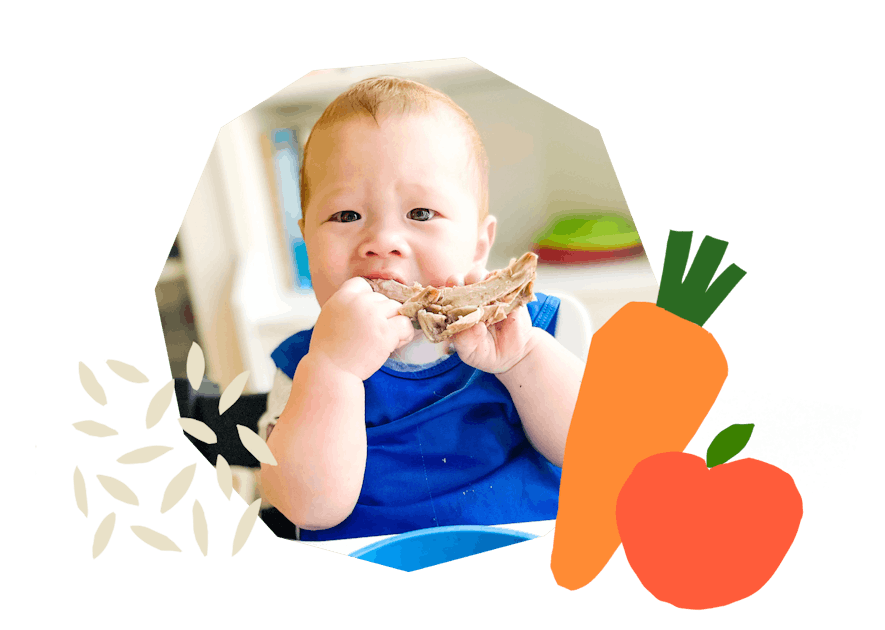
The Program Baby-Led Weaning with Katie Ferraro
A step-by-step digital program for starting solid foods safely and navigating the original 100 FIRST FOODS™ meal plan with baby-led weaning.
 EXPERT-LED, PROVEN APPROACH TO EATING REAL FOOD
EXPERT-LED, PROVEN APPROACH TO EATING REAL FOOD CONCISE VIDEO TRAININGS TO MASTER BABY-LED WEANING
CONCISE VIDEO TRAININGS TO MASTER BABY-LED WEANING 100 FIRST FOODS DAILY MEAL PLAN WITH FOOD PREP VIDEOS
100 FIRST FOODS DAILY MEAL PLAN WITH FOOD PREP VIDEOS
Baby-Led Weaning for Beginners Free Workshop
Is your baby ready to start solid foods, but you’re not sure where to start? Get ready to give your baby a solid foundation to a lifetime of loving real food…even if you’re feeling overwhelmed or confused about this next stage of infant feeding.
Get baby-led weaning recipes and tips delivered to your email inbox.

